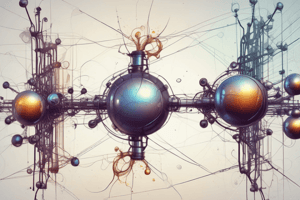Podcast
Questions and Answers
Which of the following is a common salt?
Which of the following is a common salt?
- Sodium chloride (NaCl) (correct)
- Sulfur dioxide (SO₂)
- Ethene (C₂H₄)
- Magnesium oxide (MgO)
What is the process of changing the arrangement of atoms within a molecule without breaking any chemical bonds called?
What is the process of changing the arrangement of atoms within a molecule without breaking any chemical bonds called?
- Rearrangement reactions
- Isomerization (correct)
- Acid-base reactions
- Displacement reactions
Which of the following is an example of a salt being formed through a reaction involving an acid and a base?
Which of the following is an example of a salt being formed through a reaction involving an acid and a base?
- Ethene (C₂H₄)
- Potassium carbonate (K₂CO₃)
- Sodium sulphate decahydrate (Na₂SO₄·10H₂O)
- Magnesium nitrate (Mg(NO₃)₂) (correct)
What is the general process for making salts?
What is the general process for making salts?
What is the purpose of the water (H₂O) in the reaction between Magnesium oxide (MgO) and Nitric acid (HNO₃) to form Magnesium nitrate (Mg(NO₃)₂)?
What is the purpose of the water (H₂O) in the reaction between Magnesium oxide (MgO) and Nitric acid (HNO₃) to form Magnesium nitrate (Mg(NO₃)₂)?
Which metal would displace copper from a copper compound in a displacement reaction?
Which metal would displace copper from a copper compound in a displacement reaction?
In the reaction Zn + CuSO₄ → ZnSO₄ + Cu, what is the salt formed?
In the reaction Zn + CuSO₄ → ZnSO₄ + Cu, what is the salt formed?
Which of the following is NOT a characteristic of a displacement reaction?
Which of the following is NOT a characteristic of a displacement reaction?
What is the cation in the salt ammonium nitrite (NH₄NO₂)?
What is the cation in the salt ammonium nitrite (NH₄NO₂)?
In the reactivity series, which metal is more reactive: sodium or potassium?
In the reactivity series, which metal is more reactive: sodium or potassium?
Flashcards are hidden until you start studying
Study Notes
Reactivity Series
The reactivity series is a list of metals arranged in order of their reactivity with respect to water, acids, and other reagents. The more reactive a metal is, the higher it appears in this series. A less active metal will displace a more active one from its solution when they combine, forming hydrogen gas. However, when the reaction stops, so does the formation of hydrogen gas. This concept is essential for understanding displacement reactions and the formation of salts.
Displacement Reactions
Displacement reactions occur when a less reactive metal replaces a more reactive metal in a compound or solution, resulting in the formation of a new salt. These reactions follow the rules of the reactivity series (more reactive metals replace less reactive ones), assuming all conditions remain constant. An example of a displacement reaction occurs when zinc reacts with copper sulfate, where zinc takes the place of copper in the compound:
Zn + CuSO₄ → ZnSΟ₄ + Cu
In this case, zinc (a more reactive metal) takes the position of copper in the compound, creating a new salt - zinc sulfate (ZnSO₄) and copper metal (Cu). Ammonium nitrate (NH₄NO₃) also undergoes displacement reactions, replacing sodium in sodium nitrate (NaNO₃) to form ammonium nitrite (NH₄NO₂).
Salts
Salts are ionic compounds made up of cations (positively charged ions) and anions (negatively charged ions). They can be formed through displacement reactions between a metal and a nonmetal or by combining two different compounds containing the same metal and nonmetal ions. Common salts include table salt (sodium chloride, NaCl), rock salt (potassium chloride, KCl), potash (potassium carbonate, K₀₂CO₃), and alkali chlorides, such as magnesium chloride (MgCl₂).
Rearranging Atoms
Rearrangement of atoms refers to the process of changing the arrangement of atoms within a molecule without breaking any chemical bonds. In chemistry, this term is often used to describe processes like isomerization and rearrangement reactions. Isomerization involves the conversion of one stereoisomer into another while preserving the overall molecular structure and identity. For example, Ethene (C₂H₄) changes into Propene (C₃H₆) during olefin dehydrogenation.
Making Salts
To make salts, you need a metal (or ion) to react with a nonmetal (anion) or a different ion. This process is typically achieved through a reaction involving an acid and a base. Acid–base reactions involve the transfer of protons (H+) from the base (usually an anion) to the acid (usually a cation). When these ions combine, they create a salt. Examples of making salts include:
-
Magnesium oxide (MgO) reacts with Nitric acid (HNO₃) to form Magnesium nitrate (Mg(NO₃))₂ and Water (H₂O):
2 MgO + HNO₃ → 2 Mg(NO₃)_2 + H₂O -
Sodium sulphate decahydrate (Na₂SO₄·10H₂O) is produced when Sodium bicarbonate (NaHCO₃) reacts with Sulfur dioxide (SO₂) in the presence of water (H₂O).
Studying That Suits You
Use AI to generate personalized quizzes and flashcards to suit your learning preferences.




